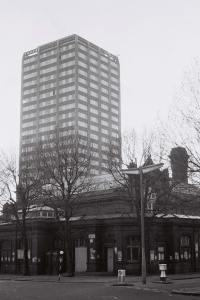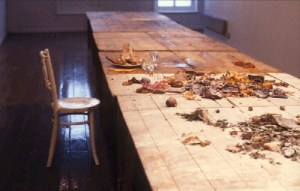The Whitechapel Gallery’s ‘archival’ show ‘Supporting Artists: Acme’s First Decade 1972–1982’, like Jon Savage’s series of photographs of Uninhabited London (shown in its entirety at Maggs Gallery a year back), depicts a long gone East End and Covent Garden of empty buildings, rotting short-life housing, urban decay and space. ‘Space’ as a name was adopted by an earlier artists’ studio organisation, set up by Bridget Riley and Peter Sedgeley and still flourishing, that made good use of similar bereft buildings.

Photo by Jon Savage Courtesy of Maggs Counterculture
At the time, this free and cheap ‘space’ in which to grow artistically (or even rot and fail) probably looked liked a compromise, a way of surviving based on squatter tactics. Now though, on the heels of the ‘rediscovery’ of ‘lost’ areas of London by property developers it feels luxurious. Acme’s avant-garde endeavour now looks like the work of ground troops of the Acme Corporation, that fictitious manufacturer supplying a cartoon coyote in the American south-west with an endlessly inventive catalogue of commodities.
The gallery walls are hung with posters of beautiful cored-out buildings, floorboards and distempered rooms in an industrial, austere Beuysian or Ballardian style. The vitrines loosely document gastro-art and DIY-style performances at long tables, such as Stuart Brisley’s 10 Days/5th Year Anniversary (1978), Kerry Trengrove’s bizarre Passage, where the artist spent 10 days tunnelling out of a concrete oubliette, and early COUM photos from Beck Road et al.
The former now resembles the East End hipster and post-hipster restaurants and speakeasies, with crappy old school assembly chairs, ‘sharing plates’, taxidermy, polytunnels and foraged foods. The fooling around with sexuality by COUM just looks like a shonkier version of the celebrity-laden hipster drag-zine Candy. The First Transvestite Style Magazine. All of it now seems like a prelude to adding more zeros to the price of refurbished buildings, constructing artist-loft-style apartments and mining a passage big enough for ‘edgy’ Superbrands to move in. Trengrove might not bother to emerge from his concrete box at all if he were around now.

10 Days/5th Year Anniversary (1978), Stuart Brisley, Acme Gallery, London
This is essentially urban ruin-porn intended to show, quite rightly, a remarkable, if at times naïve, and largely forgotten art-world before the Britart boom. The impoverished, sometimes bonkers and very sincere artists who breathed life into empty, desolate areas of London, now look like those ‘fluffers’ of the porn industry who keep the talent tumescent while there is a lull in filming to prolong the arousal for the ‘money shot’.
Acme managed to survive the gentrification process by becoming very big indeed. In the 1960s and 1970s, other more radical initiatives, such as the Albion Free State of The Republic of Frestonia (glimpsed in Savage’s 1970s photos of rubble-strewn west London) directly challenged the big road builders, urban renewalists, property developers and even the concept of a nation by issuing counter-cultural passports and possibly their own currency.
Frestonia is now just a ‘Republic of Letters’, a show of photographs by a punk historian in a Mayfair emporium and some oft-quoted faded Situationist graffiti, and Acme lives on in very concrete form with 524 studio units. I cannot speak for the anarchist Frestonian prime-movers like Heathcote Williams, but I would think that they probably prefer it like that. No handmaidens of capitalism, for them all revolutions, even artistic ones, start and end in the mind imaging the impossible, all property is theft and all that is solid melts into air.
‘Supporting Artists: Acme’s First Decade 1972–1982’ is at the Whitechapel Gallery until 23 February 2014.

Acme Corporation
Photo by Jon Savage, Courtesy of Maggs Counterculture
Share
The Whitechapel Gallery’s ‘archival’ show ‘Supporting Artists: Acme’s First Decade 1972–1982’, like Jon Savage’s series of photographs of Uninhabited London (shown in its entirety at Maggs Gallery a year back), depicts a long gone East End and Covent Garden of empty buildings, rotting short-life housing, urban decay and space. ‘Space’ as a name was adopted by an earlier artists’ studio organisation, set up by Bridget Riley and Peter Sedgeley and still flourishing, that made good use of similar bereft buildings.
Photo by Jon Savage Courtesy of Maggs Counterculture
At the time, this free and cheap ‘space’ in which to grow artistically (or even rot and fail) probably looked liked a compromise, a way of surviving based on squatter tactics. Now though, on the heels of the ‘rediscovery’ of ‘lost’ areas of London by property developers it feels luxurious. Acme’s avant-garde endeavour now looks like the work of ground troops of the Acme Corporation, that fictitious manufacturer supplying a cartoon coyote in the American south-west with an endlessly inventive catalogue of commodities.
The gallery walls are hung with posters of beautiful cored-out buildings, floorboards and distempered rooms in an industrial, austere Beuysian or Ballardian style. The vitrines loosely document gastro-art and DIY-style performances at long tables, such as Stuart Brisley’s 10 Days/5th Year Anniversary (1978), Kerry Trengrove’s bizarre Passage, where the artist spent 10 days tunnelling out of a concrete oubliette, and early COUM photos from Beck Road et al.
The former now resembles the East End hipster and post-hipster restaurants and speakeasies, with crappy old school assembly chairs, ‘sharing plates’, taxidermy, polytunnels and foraged foods. The fooling around with sexuality by COUM just looks like a shonkier version of the celebrity-laden hipster drag-zine Candy. The First Transvestite Style Magazine. All of it now seems like a prelude to adding more zeros to the price of refurbished buildings, constructing artist-loft-style apartments and mining a passage big enough for ‘edgy’ Superbrands to move in. Trengrove might not bother to emerge from his concrete box at all if he were around now.
10 Days/5th Year Anniversary (1978), Stuart Brisley, Acme Gallery, London
This is essentially urban ruin-porn intended to show, quite rightly, a remarkable, if at times naïve, and largely forgotten art-world before the Britart boom. The impoverished, sometimes bonkers and very sincere artists who breathed life into empty, desolate areas of London, now look like those ‘fluffers’ of the porn industry who keep the talent tumescent while there is a lull in filming to prolong the arousal for the ‘money shot’.
Acme managed to survive the gentrification process by becoming very big indeed. In the 1960s and 1970s, other more radical initiatives, such as the Albion Free State of The Republic of Frestonia (glimpsed in Savage’s 1970s photos of rubble-strewn west London) directly challenged the big road builders, urban renewalists, property developers and even the concept of a nation by issuing counter-cultural passports and possibly their own currency.
Frestonia is now just a ‘Republic of Letters’, a show of photographs by a punk historian in a Mayfair emporium and some oft-quoted faded Situationist graffiti, and Acme lives on in very concrete form with 524 studio units. I cannot speak for the anarchist Frestonian prime-movers like Heathcote Williams, but I would think that they probably prefer it like that. No handmaidens of capitalism, for them all revolutions, even artistic ones, start and end in the mind imaging the impossible, all property is theft and all that is solid melts into air.
‘Supporting Artists: Acme’s First Decade 1972–1982’ is at the Whitechapel Gallery until 23 February 2014.
Unlimited access from just $16 every 3 months
Subscribe to get unlimited and exclusive access to the top art stories, interviews and exhibition reviews.
Share
Recommended for you
Flesh over Bone
Francis Bacon wins the latest bout between artistic heavyweights, against Henry Moore at the Ashmolean
In the Eye of the Collector
‘Désirs et Volupté’, a selection of Victorian art from the Pérez Simón collection at the Musée Jacquemart-André, won’t be to everyone’s taste
Revival: Laura Ashley
An exhibition at the Bowes Museum proves that Laura Ashley’s influence lives on